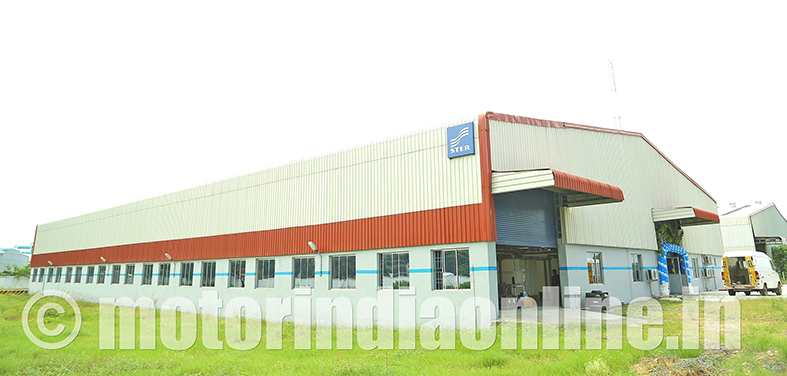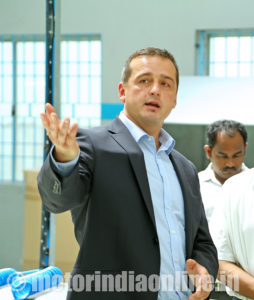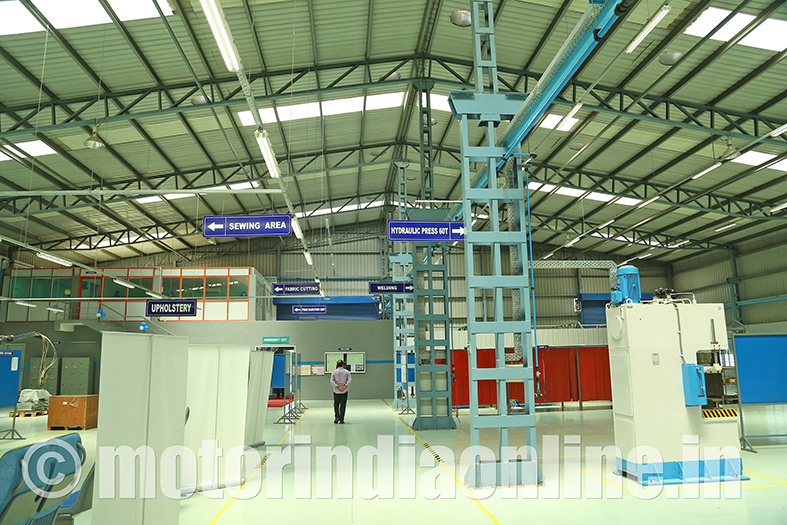Long-term plan to cater to expanding local and export markets
Companies with an insatiable appetite for growth invariably move out of their comfort zone and spread their wings across global markets to tap the immense business opportunities available. In such endeavours, many enter these markets directly and set up their own business operations right from the word ‘go’. While such entries are based on extensive market research, vast databank and, of course, complemented by deep pockets, the mid-size companies, with an eye on the costs, popularly resort to the indirect route. They go thro’ the dealer or distributor network also to get a feel of the ground realities and cultural ethos of the region before taking the plunge to set up their sales network and/or manufacturing facilities. One doesn’t come across that frequently – the mid-size firms entering the market directly and that too in manufacturing.
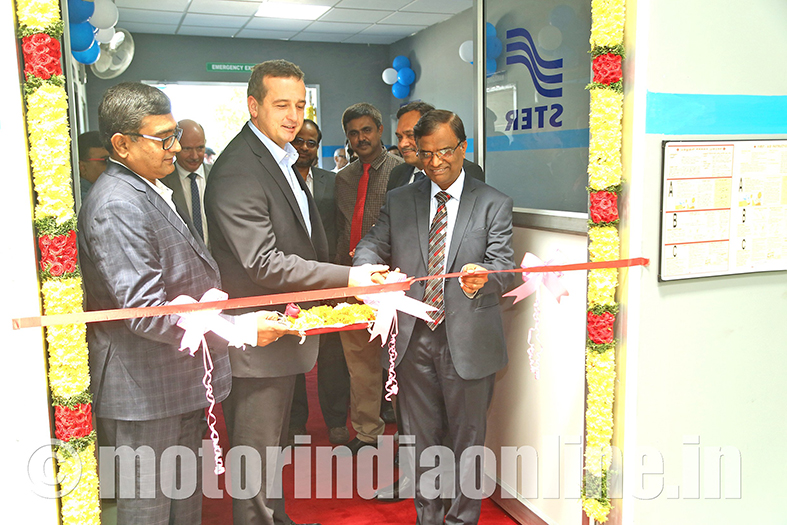
Well, we at MOTORINDIA had an opportunity to bump into one such firm and the privilege of being present on the occasion of its factory inauguration on September 22 at Irungattukottai, the auto hub bordering Chennai. The company referred to here is Ster India Private Ltd., a wholly-owned subsidiary of the Poland-based seats manufacturer for the transport segment, Ster Sp. z.o.o., one of the global leaders in the field.
The factory set for inauguration was aptly decorated to suit the occasion and there was palpable excitement in the air, and why not? The India team headed by Mr. N. Vaideshwaran, Managing Director, ably supported at all stages by the Polish team had worked with great commitment and enthusiasm to give a shape to the dreams of their Principal, and in doing so, making a strong statement thro’ their ‘Make in India’ venture.
The Polish team comprising Mr. Piotr Nowak, Sales Director, and Mr. Andrzej Tkacz (LLM), International Expansion Projects Coordinator, was present for that milestone day. The Chief Guest on the occasion was Dr. A.K. Jindal, Vice President & Head Engineering (CVBU), Engineering Research Centre, Tata Motors Ltd. Also present were the end customers, bus body builders, machinery suppliers, media, bankers and other well-wishers.
After the traditional lamp lighting ceremony and formal opening by Dr. Jindal, the Ster team took the invitees around the factory to show the machinery and finished products displayed. Mr. Nowak briefly outlined the factory lay-out and the operations of a few of the critical machines like foam injection unit, metal working press and upholstery sewing units. The demo of the foam injection unit and the importance of controlling various parameters to get the desired density were explained.
Mr. Nowak also highlighted the special features of the seats displayed and demonstrated the ease of assembly, disassembly and interchangeability.
Ster made a beginning with a hall of about 2500 sq.mt. and installed in it the machines needed for the basic operations and assembly. Many of the parts are currently imported from Poland, and over a period of time, they want to add on more of the floor area and settle at about 25,000 sq.mt. for the envisaged operations. They want to have a unit in India similar to the one in Poland. An Injection moulding machine for plastic components will be added shortly and they aim to install 10 machines in due course to meet the production demands.
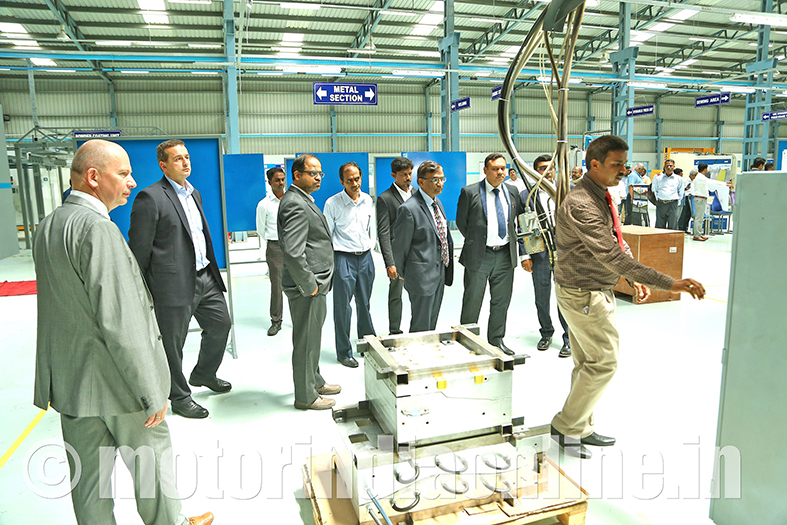
Their plan is to have two production lines, fully automatic. The first line is expected to cater to the needs of the bus industry and the second line to seats for higher end like that for railways, tubes/metros, trams and bus segment conforming to advanced regulations.
They want to have all the operations under one roof to meet the customer demands. Metal parts may be outsourced but there will be no compromise on the quality standards. With bus regulations around the corner, they would like to supply their seats matching the European standards and at the same time meeting the specific requirements of the Indian conditions.
We caught up with Mr. Nowak after the customary launch for an exclusive interview. Mr. Nowak had cautioned us that he can go on for ages talking on the seats topic and we found that very much true during the absorbing interaction. With many more disruptions likely to unfold in the CV domain, the Indian bus market structure is likely to go through radical changes during the next decade. In that changed scenario we are going to witness new players emerge, to lead and set the trend in their segments; and it is certain that Ster is going to be one amongst in that class, manufacturing in overdrive to meet the local and export market demands in a big way.
Upbeat on future prospects
“Our bus seats manufacturing industry is different from that of automotive production. In the automotive line, you have suppliers and sub-suppliers and sometimes it’s just assembly work that is going on. In our case, we don’t have a long service lead time. Customers are very demanding, want us to meet customisation, stringent specifications and the service deadline. That means we have to be flexible to meet demands of varied customers requiring seats for a single bus to 1,000 buses or more,” says Mr. Piotr Nowak, Sales Director, who is upbeat about the local and export markets.
Read on for the excerpts of his absorbing insights:
Can you explain the reason for making a direct entry with own investments and the choice of Chennai for putting up the plant?
We have been visiting India often for the last 8 years to assess the right time and approach to enter the Indian market. During those visits, we had met several of the leading body builders, OEMs, customers, and suppliers and developed a good feel of, and perception for the Indian market requirements and the challenges. We understood India was a big and difficult market, and after due deliberations took that important decision of entering the market with our own investments. The Bus Body Building Regulations were shaping up at that juncture and that meant opening up of great opportunities for companies like us, with the regulations being applicable for all sub-assemblies in body building.
Also, our European customers like Daimler, Scania, MAN and Volvo, already present and established in India, were asking us to produce seats for the local and as well as export markets. Thus we entered with the twin objectives of local and exports with India as the manufacturing hub to meet the requirements of the Asian and African countries. Plant location in South India was advantageous for us as four of the leading CV manufacturers were located in the region. Chennai suited well because of the ready availability of trained technical manpower and our plans to export products to other countries.
Please share your observations of the local market requirements for the varied products vis-a-vis Europe and other countries.
I had the initial impression that we would be exporting a major portion of the production, but that viewpoint has now changed after interacting with our customers. The number of enquiries and the various questions pertaining to the seats for diverse applications have surprised us. I can now envisage an equal share of our products for local and export markets. Every market requirement is different and unique, and could range from sofa type seats to foam & fabric and fully plastic depending upon the applications. The seats are invariably customised and hence we need to supply those suited for Indian conditions.
Our initial feedback says there is a strong preference for foam and fabric combination, but we can provide all combinations as per the needs. We want to ensure that that seats will be of European standard and adhere to the comfort and local safety norms. We already have orders from both the local markets and from Malaysia and Indonesia.
What about your global operations and the products supplied for the segments? Can you disclose the products identified for the Indian market and future plans?
Our main factories and head office are in Poland. In the first factory in Poland we produce special, driver and railway seats. The second factory is only for meeting the seat needs of urban and inter-city coaches. Our technology/design and R&D departments take care of the new developments, prototype testing, homologation and organising production line for the manufacturing process. As the production lines have to meet the short service lead times and customisation, we need to have that flexibility to meet the diverse models in each class of seats. We are the leaders in urban bus seats and produce seats in partnership with the US and China and have assembly operations in many other countries like Sweden, Israel, etc.
We have identified seats for city/urban (New city & MB), high back inter-city (Sapphire) which conforms to UBS-II norms, inter-city coach (Rubin) and driver’s seat (B series) to begin with. It may be noted that there are over 30 variations in each model to meet the diverse fleet needs. These are simple to assemble with interchangeable parts and easy to produce in the factory and meet up to the European norms and local regulations. We will be introducing other models in line with the ramp-up in production facilities and infrastructure.
Apprise us of product features and the USPs to score over the competition. How do you see local regulations shape up the demand for your products?
Our seats are ultralight but strong and durable to meet tough conditions, including the typical urban realities like kicking, writing, using knives for carving, scratching, etc. The seats are characterised by simplicity in design and the universal parts can be easily exchanged at garages by unskilled workers so that the buses do not get delayed for service. Seats are fire retardant, antibacterial and designed to take the impact energy during accidents for passenger safety. Long guarantees can be provided, and yes, it comes at a price; but then, with the growing awareness for safety, necessity to meet regulations in local and export markets, customers are showing keen interest in Ster products.
What are your other areas of operation besides seats for the bus segment? How do you see the bus seat industry shaping up?
Apart from the seats for city / urban, high back & inter-city coach and driver’s seats, we are supplying seats for railways and marine applications. We also produce aluminium components like extension cups and connectors, apart from aluminium hand pulls and anti-bacterial hand pulls. Our customers in Europe are primarily OEMs like Volvo, Scania, MAN, Solaris, etc. In Europe, many of the independent body builders have disappeared in the last 10 years, not being able to meet the stringent bus regulations. The same has happened in the seat manufacturing segment too. Two of us, including Ster, supply more than 90% of the bus needs. I feel that the same trend will evolve in India too, may be in the next decade.
Design and documentation to meet the stringent regulations involve major investments and only OEMs can afford to do it as they have a large market base to address and follow up. Of course till such a situation develops, all the bus body builders are our customers and we will be offering the same level of service to them irrespective of the order size.
